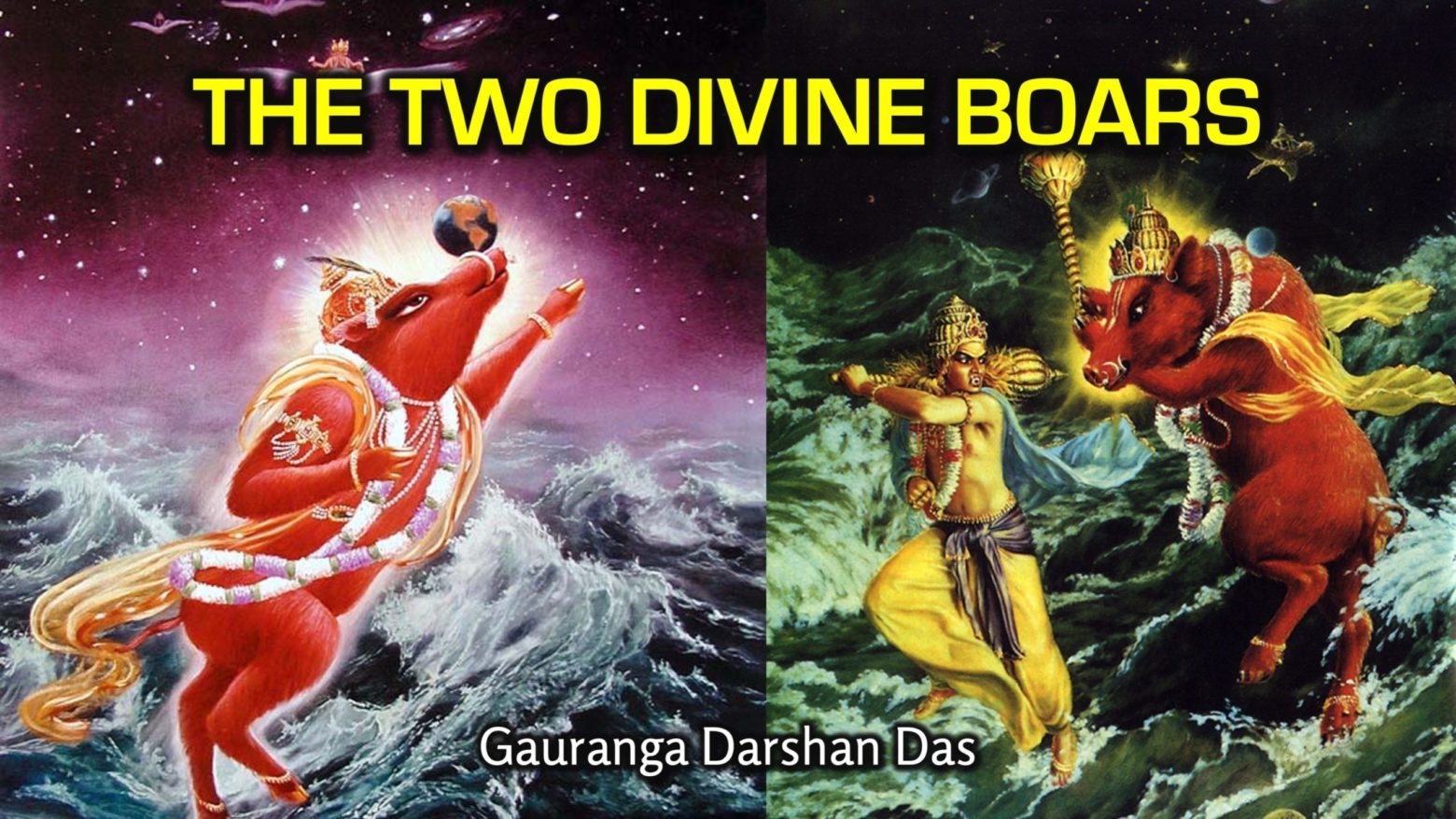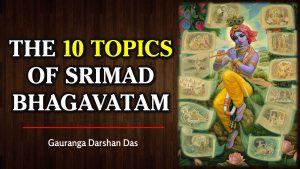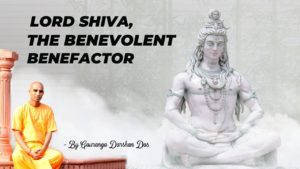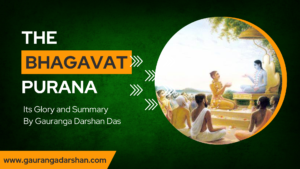THE TWO DIVINE BOARS
by Gauranga Darshan Das
(Varāha Dvādasi Special)
Boar is a wild animal, probably not known for its beauty or great work. But when God appears in the form of a boar, He looks extremely beautiful and performs the most wonderful deeds. Just as the Supreme Lord appears in the human society as Lord Rāma and Lord Kṛṣṇa, He also incarnates in the animal society as Varāha (Boar), amongst the birds as Haṁsa (Swan), amongst the aquatics as Matsya (Fish) and so on.
According to Śrīmad Bhāgavatam, the Supreme Lord appeared as Varāha (a wild boar) twice – once as Ādi-varāha or Śveta-varāha in the Svāyambhuva (first) manvantara and another time as Nīla-varāha or Rakta-varāha in the Cākṣusa (sixth) manvantara. As Śveta-varāha He retrieved the Earth from the depths of Garbhodaka ocean, and as Nīla-varāha, He killed a powerful demon named Hiraṇyākṣa. This article describes the appearance and activities of these two divine boar incarnations of the Supreme Lord.
ĀDI-VARĀHA or ŚVETA-VARĀHA
in SVĀYAMBHUVA (FIRST) MANVANTARA
Lord Brahmā was the first created being in this universe. He appeared from a lotus that sprouted from the navel of the Supreme Lord Viṣṇu. Having been enlightened personally by the Supreme Lord, Brahmā began his service of creation. His first task was to populate the universe with various types of living entities.
Once, as Brahmā was deliberating on how to accomplish his duty, two personalities appeared from his body. They were Svāyambhuva Manu and his queen Śatarūpā. Manus are the progenitors of mankind. There are fourteen Manus in a day of Brahmā, which lasts for 1000 divya-yugas (divya-yuga is a combination of the four yugas namely Satya, Treta, Dvāpara, and Kali). The reign of a Manu is called Manvantara which lasts for about 71 divya-yugas. The calculation of cosmic time is wonderful to the human thought process that’s accustomed to seeing time only in terms of minutes, hours, days, and years only. The first Manu Svāyambhuva was ready to abide by Brahmā’s instruction to procreate, but he found that there was no place to perform his service since the Earth was merged in the Garbodhaka ocean at that time.
How Is the Boar Divine? – Brahmā contemplated on how to raise the Earth, “While I am creating, the Earth has been inundated. What can we do? Let the Almighty Lord direct us.” Then a small form of Boar (Śveta Varāha), in the size of a thumb, came out of Brahmā’s nostril and within a moment, it grew gigantic in the sky like a great elephant. Whenever there is an emergency in the universe or an acute rise of adharma in this world, the Supreme Lord appears in a suitable form to rectify the situation. Because the Earth was submerged in the ocean, the Lord appeared as a wild boar to retrieve the Earth with His tusks. That is His transcendental pastime. Just because the Lord appeared in the form of a Boar, His potency doesn’t reduce, nor is this form inferior in its divinity. The Lord’s form in any shape is always transcendental and full of knowledge and mercy.
How Does the Boar’s Roar Dispel Fear? – Seeing the gigantic mountainlike Boar, Brahmā and his sons were struck with wonder. To enliven them, Lord Varāha, the master of sacrifices, then roared tumultuously. Because Brahmā and other enlightened brāhmaṇas have the divine knowledge about the Supreme Lord, they are enlivened by His appearance in any of His multi-incarnations. Therefore, the all-auspicious sound (roar) of the all-merciful Lord that echoed in all directions, reassured His devotees, causing them fearlessness. Hearing the thundering roar of the Boar incarnation of Viṣṇu, they didn’t become fearful. The Lord’s resounding roar is an open threat to all demons who might challenge His omnipotence, but to His devotees, that very roar is a reassuring boon.
Why is Varāha the Personification of Vedas? – The Vedas are said to be the breath of the Supreme Lord, and that breath was inhaled by Brahmā, who was enlightened in the Vedic knowledge, by the Supreme Lord Himself. Because Lord Varāha appeared from the nostril of Brahmā, when he breathed out, Varāha is said to be the personification of the Vedas (veda-vitāna-mūrti). The denizens of higher planets named Jana, Tapa, and Satya-lokas chanted mantras from the three Vedas praising Varāhadeva. Śrīla Prabhupāda writes, “Whenever there is a glorification of the Lord, it is to be understood that Vedic mantras are being rightly vibrated. The Lord was therefore pleased when such Vedic mantras were chanted, and to encourage His pure devotees, He roared once more and entered the water to rescue the submerged Earth.” (SB 3.13.26 Purport). The Lord has no material form, but His form is always understood in terms of the Vedas. Because the Lord’s form is personified Vedic knowledge, He is the destroyer of all material contamination.
How Did Śveta Varāha Rescue The Earth? – Lord Varāha entered the water playing like an elephant (gajendra-lélā), and flew in the sky, with His tail slashing and His hard hairs quivering. His glance was luminous (like sun and moon). He scattered the clouds with His hooves and white tusks. Although transcendental, He imitated the actions of a Boar and searched after the Earth by smell. His tusks were fearful. He glanced over the sages who were offering prayers and entered the water. He dived into the ocean, whose high waves appeared like its arms as if praying, “O Lord, please protect me and do not cut me in two!” Cleaving the water with His sharp hooves, the Lord found the limits of the unlimited ocean and saw the Earth, and personally lifted it. Thus, He protected the Earth.
NĪLA-VARĀHA or RAKTA-VARĀHA
in CĀKṢUSA (SIXTH) MANVANTARA
The above incident took place in the Svāyambhuva (first) manvantara. The Lord again appeared in the Cākṣusa (sixth) manvantara, as Rakta Varāha and protected the Earth by killing a demon named Hiraṇyākṣa. The following is the story behind this.
What are the Consequences of an Untimely Union? – Kaśyapa Muni was the son of Brahmā. One of his wives, Diti, was once afflicted by lust and an intense desire for a child. Being impatient and envious of her cowives who already had children, Diti approached Kaśyapa in the evening time for union. Kaśyapa dissuaded her saying that the time was inauspicious, as ghosts and their master, Śiva, move about at that time. However, Diti was pressed by Cupid and pulled Kaśyapa by his clothing. Not being so self-controlled, Kaśyapa also gave in to her advances and obliged her unreasonable appeal, uniting with her. Ignorance is not the cause of every mistake. Even, persons in knowledge, commit mistakes due to weak-heartedness and temptations for momentary pleasures. Afterward, Kaśyapa addressed Diti in disdain, “Everything was inauspicious because of your mind’s pollution, defilement of time, negligence of my directions, and apathy towards demigods. As a result, you will have two demoniac sons who will constantly afflict the three worlds, kill innocent and sinless entities, torture women, enrage great souls, and ultimately be killed by the Supreme Lord.” Diti became repentant. Seeing her transformation and patience, Kaśyapa encouraged her, “Your grandson (Prahlāda) will be a great devotee.” This somewhat pacified the aggrieved Diti. Diti held her sons in the womb for 100 years, wanting to delay the trouble of the demigods by her sons and also the death of her sons at the hands of the Lord. By the force of her pregnancy, darkness spread in all directions. The demigods were perplexed and approached Brahmā. Brahmā then narrated the background story of the children in Diti’s womb.
How Did Those Devotees Become Demons? – Once, the four Kumāras had gone to Vaikuṇṭha to see Lord Viṣṇu. They crossed six gates without any obstruction, but at the seventh gate, they were blocked by Jaya and Vijaya, the doorkeepers. The Kumāras were agitated and spoke thus, “How are you suspecting others? Where is the possibility of an enemy coming to Vaikuṇṭha? The apt punishment for you imposters is to go to the material world filled with vices.” Jaya and Vijaya fell at the feet of the Kumāras and prayed that they never forget the Lord. Seeing their humility, the Kumāras felt repentant. Understanding the situation, Lord Viṣṇu appeared there and pacified the lamenting doorkeepers with His affectionate glance, and consoled the fearful Kumāras with His pleasing smile. Viṣṇu humbly apologized to the Kumāras for the offense of Jaya and Vijaya, and said, “The punishment given by you to My doorkeepers, of becoming demons in the material world, was ordained by Me. They will very soon return to Me, meditating on Me in anger.” An ideal master takes responsibility for the mistakes of His servants and helps them without disowning them.
Does God Like to Fight? – The Kumāras circumambulated the Lord and departed. Lord Viṣṇu spoke to Jaya and Vijaya, “Do not fear. Though you will have the mentality of demons, you will always think of Me and serve Me. I will experience pure happiness by fighting with you two.” Only the devotees can satisfy the Lord in every respect, including giving Him the pleasure of fighting. Thus, Jaya and Vijaya left Vaikuṇṭha and entered Diti’s womb. After 100 years of pregnancy, Diti gave birth to her twin sons. Kaśyapa named them Hiraṇyakaśipu and Hiraṇyākṣa. Hiraṇyakaśipu performed austerities and received boons from Brahmā. He started to control all three worlds. Hiraṇyākṣa traveled all over the universe with a fighting spirit. His form, temper, and power scared the demigods. Desiring to sport, he entered the ocean and reached Vibhāvarī, the capital of Varuna, and provoked him for a fight. Varuṇa intelligently replied, “I have grown too old. Only Lord Viṣṇu can satisfy your desire to fight.”
Why Does God Fight with Devotees? – Hiraṇyākṣa learned from Nārada Muni the Lord’s whereabouts and entered into the Garbodhaka ocean. There, he saw the Lord in the form of a boar (Varāha), bearing the Earth on His tusks. He criticized the Lord with ill-names and addressed Him like an animal, forest-dweller, lowest of demigods, and so on. The Lord was pained by these abusive words. God is as sentient as we are. He is satisfied by our prayers and dissatisfied by our harsh words against Him. Seeing that the Earth was frightened, the Lord bore the pain and rose out of water. Varāhadeva challenged Hiraṇyākṣa and after a fierce battle with him, the Lord slapped him in the root of the ear. The demon fell dead like an uprooted tree. Though the Lord could instantly kill the demons, He fights with them just to experience the pleasure of fighting. Śrīla Prabhupāda writes, “Sometimes a father takes pleasure in having a mock fight with his small child, and similarly the Lord felt Hiraṇyākṣa’s striking on His body to be like flowers offered for worship. In other words, the Lord desired to fight to enjoy His transcendental bliss; therefore, He enjoyed the attack.” (SB 3.19.16 Purport)
Lord Varāha was glorified by the sages as follows:
namo namas te ‘khila-mantra-devatā-
dravyāya sarva-kratave kriyātmane
vairāgya-bhaktyātmajayānubhāvita-
jñānāya vidyā-gurave namo namaḥ
“O Lord, You are the Supreme Personality of Godhead and are worshipable by universal prayers, Vedic hymns, and sacrificial ingredients. We offer our obeisances unto You. You can be realized by the pure mind freed from all visible and invisible material contamination. We offer our respectful obeisances to You as the supreme spiritual master of knowledge in devotional service.” (SB 3.13.39)
Thus, accomplishing the mission of the demigods, Lord Varāha returned to His own abode being glorified by them.
Gauranga Darshan Das, a disciple of His Holiness Radhanath Swami, is the dean of the Bhaktivedanta Vidyapitha at ISKCON Govardhan Eco Village (GEV), outside Mumbai, and a member of ISKCON Board of Examinations (BoEx). He is a sastric teacher and is the author of Gita Subodhini, Bhagavata Subodhini, Caitanya Subodhini, Disapproved but Not Disowned, Bhagavata Pravaha and other books.




